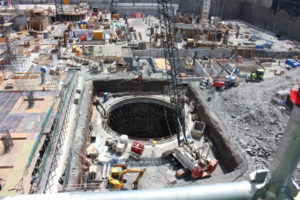The Well in downtown Toronto
Building up, digging down

Photo courtesy Enwave Energy Corporation
As Enwave digs down, RioCan REIT and Allied Properties REIT are building several stories up, making the construction of such a massive project increasingly complex.
“Levels and columns of the buildings are going up, elevator shafts are being built up, walls are going up, but the hole for the thermal storage tank is being left open,” says Scharbach. “Parts of the tank and the concrete slab above it will also be holding up one of the buildings, so it is also playing a role in the foundation of the structure being built on top of it.”
Working around a 43-m hole in the middle of the construction site has made communication between the 400-plus workers onsite, suppliers, and contractors essential.
“All of the structural pieces for that section of the project are on hold until we are done the tank,” says Scharbach. “There is a certain amount of organizational co-ordination, and synchronization in general, between all trades and contractors. We also have to navigate delivery of materials from various suppliers through one of the city’s busiest areas.”
The buildings will be built using construction materials consisting of 20 per cent recycled and 30 per cent regional content, by cost, to help support the local economy and shrink the project’s environmental footprint. At least half of the wood purchased for the build will be Forest Stewardship Council (FSC)-certified, meaning it was sourced from a sustainably managed forest, and 75 per cent of the demolition and construction waste will be diverted from landfills to further the project’s commitment to sustainability.
The completed commercial buildings will utilize reused rainwater to flush toilets and urinals in efforts to reduce the potable water demand for plumbing fixtures by 63 per cent, saving 21 million L (5.5 million gal) of fresh water annually. Other features will include light-emitting diode (LED) luminaries, carbon dioxide (CO2) censors to control fresh airflow, and bird fritting on windows.
Coming together

Image courtesy Enwave Energy Corporation, RioCan REIT, and Allied Properties REIT
The project began with a conversation between Enwave and Allied properties about the Well site and the potential to incorporate a district energy network that would feed the new development. Many previous conversations had occurred to discuss the concept with different developers, and a lot of things began to line up with the Well in terms of the mindset of the developers as community builders. Although setting aside ‘business-as-usual’ and doing something different, like thermal storage, can feel risky to many business leaders, challenging expected norms in the construction, development, and energy industries is necessary to provide sustainable solutions.
Once there was initial agreement in concept, Enwave, Allied, and RioCan went through a series of negotiations before starting the project in 2017, with the goal of having the first tenant move in by the summer of 2021.
This collaboration is the first-of-its-kind in Canada and will be an example of how like-minded partners can pursue and implement future-focused, clean energy initiatives. The project will unlock the potential for long-term greenhouse gas (GHG) emission reductions thus contributing to the City of Toronto’s targets (30 per cent by 2020), as outlined in TransformTO.
“The Well will now support two elements of a modern and progressive city: resilience and the need to decarbonize municipal energy supplies,” said Michael Emory, Allied’s chief operating officer.
Thermal storage facilities and district energy networks like the one in the Well project will also allow the city to decentralize energy supply and reduce the load on the electricity grid since traditional chillers will not be running during peak summer periods. Increased resilience for the development and neighbouring communities, coming from the use of DLWC, reduced energy use, and redundancy built into the district energy network, is another impactful benefit to all involved as well as the city. Finally, the western expansion of Enwave’s district system means there are more opportunities to provide sustainable energy to a new area of Toronto, where intelligent energy planning can help ensure the responsible future growth of communities.
 Alison Knight is the operations assistant at Enwave Energy Corporation and works closely with the engineers involved in running and maintaining Toronto’s district energy system. She graduated from the University of Western Ontario with a BA (Hons.) in information, media, and technology studies and earned an Ontario College Graduate Certificate with honours in new media journalism. Knight previously worked as an editor at both Sportsnet and Postmedia Network. She can be reached at alison.knight@enwave.com.
Alison Knight is the operations assistant at Enwave Energy Corporation and works closely with the engineers involved in running and maintaining Toronto’s district energy system. She graduated from the University of Western Ontario with a BA (Hons.) in information, media, and technology studies and earned an Ontario College Graduate Certificate with honours in new media journalism. Knight previously worked as an editor at both Sportsnet and Postmedia Network. She can be reached at alison.knight@enwave.com.







